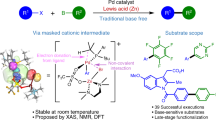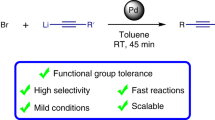Abstract
Catalytic carbon–carbon bond formation based on cross-coupling reactions plays a central role in the production of natural products, pharmaceuticals, agrochemicals and organic materials. Coupling reactions of a variety of organometallic reagents and organic halides have changed the face of modern synthetic chemistry. However, the high reactivity and poor selectivity of common organolithium reagents have largely prohibited their use as a viable partner in direct catalytic cross-coupling. Here we report that in the presence of a Pd-phosphine catalyst, a wide range of alkyl-, aryl- and heteroaryl-lithium reagents undergo selective cross-coupling with aryl- and alkenyl-bromides. The process proceeds quickly under mild conditions (room temperature) and avoids the notorious lithium halogen exchange and homocoupling. The preparation of key alkyl-, aryl- and heterobiaryl intermediates reported here highlights the potential of these cross-coupling reactions for medicinal chemistry and material science.
This is a preview of subscription content, access via your institution
Access options
Subscribe to this journal
Receive 12 print issues and online access
$259.00 per year
only $21.58 per issue
Buy this article
- Purchase on Springer Link
- Instant access to full article PDF
Prices may be subject to local taxes which are calculated during checkout



Similar content being viewed by others
Change history
17 June 2013
In the version of this Article originally published online, there are three instances where the compound 2u should have been 2x: twice in Table 1, and once in the section 'Pd-catalysed cross-coupling with alkyllithium reagents.' Also in that section, 2s-2v should have been 2v-2y. These errors have been corrected in the HTML and PDF versions of the Article.
References
Negishi, E. Magical power of transition metals: past, present, and future. Angew. Chem. Int. Ed. 50, 6738–6764 (2011).
Nicolaou, K. C., Bulger, P. G. & Sarlah, D. Palladium-catalyzed cross-coupling reactions in total synthesis. Angew. Chem. Int. Ed. 44, 4442–4489 (2005).
Corbet, J. & Mignani, G. Selected patented cross-coupling reaction technologies. Chem. Rev. 106, 2651–2710 (2006).
Magano, J. & Dunetz, J. R. Large-scale applications of transition metal-catalyzed couplings for the synthesis of pharmaceuticals. Chem. Rev. 111, 2177–2250 (2011).
Johansson Seechurn, C. C. C., Kitching, M. O., Colacot, T. J. & Snieckus, V. Palladium-catalyzed cross-coupling: a historical contextual perspective to the 2010 Nobel Prize. Angew. Chem. Int. Ed. 51, 5062–5085 (2012).
Lyons, T. W. & Sanford, M. S. Palladium-catalyzed ligand-directed C−H functionalization reactions. Chem. Rev. 110, 1147–1169 (2010).
Phipps, R. J. & Gaunt, M. J. A meta-selective copper-catalyzed C–H bond arylation. Science 323, 1593–1597 (2009).
Ball, L. T., Lloyd-Jones, G. C. & Russell, C. A. Gold-catalyzed direct arylation. Science 337, 1644–1648 (2012).
Stille, J. K. The palladium-catalyzed cross-coupling reactions of organotin reagents with organic electrophiles. Angew. Chem. Int. Ed. 25, 508–524 (1986).
Espinet, P. & Echavarren, A. M. The mechanisms of the Stille reaction. Angew. Chem. Int. Ed. 43, 4704–4734 (2004).
Suzuki, A. Cross-coupling reactions of organoboranes: an easy way to construct C–C bonds. Angew. Chem. Int. Ed. 50, 6722–6737 (2011).
Miyaura, N. in Metal Catalyzed Cross-Coupling Reactions Vol. 1 (eds De Meijere, A. & Diederich, F.) 41–123 (Wiley-VCH, 2004).
Knochel, P. & Singer, R. D. Preparation and reactions of polyfunctional organozinc reagents in organic synthesis. Chem. Rev. 93, 2117–2188 (1993).
Phapale, V. B. & Cárdenas, D. J. Nickel-catalysed Negishi cross-coupling reactions: scope and mechanisms. Chem. Soc. Rev. 38, 1598–1607 (2009).
Hiyama, T. & Nakao, Y. Silicon-based cross-coupling reaction: an environmentally benign version. Chem. Soc. Rev. 40, 4893–4901 (2011).
Denmark, S. E. & Regens, C. S. Palladium-catalyzed cross-coupling reactions of organosilanols and their salts: practical alternatives to boron- and tin-based methods. Acc. Chem. Res. 41, 1486–1499 (2008).
Tamao, K., Sumitani, K. & Kumada, M. Selective carbon–carbon bond formation by cross-coupling of Grignard reagents with organic halides. Catalysis by nickel–phosphine complexes. J. Am. Chem. Soc. 94, 4374–4376 (1972).
Knappe, C. E. I. & von Wangelin, A. J. 35 years of palladium-catalyzed cross-coupling with Grignard reagents: how far have we come? Chem. Soc. Rev. 40, 4948–4962 (2011).
Rappoport, Z. & Marek, I. The Chemistry of Organolithium Compounds (Wiley-VHC, 2004).
Miyaura, N. & Suzuki, A. Palladium-catalyzed cross-coupling reactions of organoboron compounds. Chem. Rev. 95, 2457–2483 (1995).
Hartwig, J. F. Borylation and silylation of C–H bonds: a platform for diverse C–H bond functionalizations. Acc. Chem. Res. 45, 864–873 (2012).
Murahashi, S., Yamamura, M., Yanagisawa, K., Mita, N. & Kondo, K. Stereoselective synthesis of alkenes and alkenyl sulfides from alkenyl halides using palladium and ruthenium catalysts. J. Org. Chem. 44, 2408–2417 (1979).
Nagaki, A., Kenmoku, A., Moriwaki, Y., Hayashi, A. & Yoshida, J. Cross-coupling in a flow microreactor: space integration of lithiation and Murahashi coupling. Angew. Chem. Int. Ed. 49, 7543–7547 (2010).
Smith, A., Hoye, A. T., Martinez-Solorio, D., Kim, W. & Tong, R. Unification of anion relay chemistry with the Takeda and Hiyama cross-coupling reactions: identification of an effective silicon-based transfer agent. J. Am. Chem. Soc. 134, 4533–4536 (2012).
Pérez, M. et al. Catalytic asymmetric carbon–carbon bond formation via allylic alkylations with organolithium compounds. Nature Chem. 3, 377–381 (2011).
Denmark, S. E., Smith, R. C., Tau, W. T. & Muhuhi, J. M. Cross-coupling reactions of aromatic and heteroaromatic silanolates with aromatic and heteroaromatic halides. J. Am. Chem. Soc. 131, 3104–3118 (2009).
Martin, R. & Buchwald, S. L. Palladium-catalyzed Suzuki–Miyaura cross-coupling reactions employing dialkylbiaryl phosphine ligands Acc. Chem. Res. 41, 1461–1473 (2008).
Merrill, R. E. & Negishi, E. Tetrahydrofuran-promoted aryl–alkyl coupling involving organolithium reagents. J. Org. Chem. 39, 3452–3453 (1974).
Kataoka, N., Shelby, Q., Stambuli, J. P. & Hartwig, J. F. Air stable, sterically hindered ferrocenyl dialkylphosphines for palladium-catalyzed C–C, C–N, and C–O bond-forming cross-couplings. J. Org. Chem. 67, 5553–5566 (2002).
Fu, G. C. The development of versatile methods for palladium-catalyzed coupling reactions of aryl electrophiles through the use of P(t-Bu)3 and PCy3 as ligands Acc. Chem. Res. 41, 1555–1564 (2008).
Han, C. & Buchwald, S. L. Negishi coupling of secondary alkylzinc halides with aryl bromides and chlorides. J. Am. Chem. Soc. 131, 7532–7533 (2009).
Jana, R., Pathak, T. P. & Sigman, M. S. Advances in transition metal (Pd,Ni,Fe)-catalyzed cross-coupling reactions using alkyl-organometallics as reaction partners. Chem. Rev. 111, 1417–1492 (2011).
Lundgren, R. J. & Stradiotto, M. Addressing challenges in palladium-catalyzed cross-coupling reactions through ligand design. Chem. Eur. J. 18, 9758–9769 (2012).
Li, H., Johansson Seechurn, C. C. C. & Colacot, T. J. Development of preformed Pd catalysts for cross-coupling reactions, beyond the 2010 Nobel Prize. ACS Catal. 2, 1147–1164 (2012).
Anctil, E. J. & Snieckus, V. in Metal Catalyzed Cross-Coupling Reactions Vol. 1 (eds De Meijere, A. & Diederich, F.) 761–813 (Wiley-VCH, 2004).
Stoit, A., Iwema Bakker, W. I., Coolen, H., van Dongen, M. & Leflemme, N. J. Spiro-cyclic amine derivatives as S1P modulators. PCT patent application WO 2012004378 (A1) (2012).
Doucet, H. Suzuki–Miyaura cross-coupling reactions of alkylboronic acid derivatives or alkyltrifluoroborates with aryl, alkenyl or alkyl halides and triflates. Eur. J. Org. Chem. 2013–2030 (2008).
Woon, K. L. et al. Electronic charge transport in extended nematic liquid crystals. Chem. Mater. 18, 2311–2317 (2006).
Liu, L. et al. Effect of oligothienyl chain length on tuning the solar cell performance in fluorene-based polyplatinynes. Adv. Funct. Mater. 18, 2824–2833 (2008).
Acknowledgements
The authors thank the Netherlands Organization for Scientific Research (NWO-CW), the National Research School Catalysis (NRSC-C) and the European Research Council (ERC advanced grant 227897 to B.L.F.) for financial support.
Author information
Authors and Affiliations
Contributions
M.G. and M.F.-M. performed the experiments. M.G., M.F.-M. and B.L.F. designed the experiments, analysed the data and wrote the manuscript. B.L.F. guided the research.
Corresponding author
Ethics declarations
Competing interests
The authors declare no competing financial interests.
Supplementary information
Supplementary information
Supplementary information (PDF 1713 kb)
Rights and permissions
About this article
Cite this article
Giannerini, M., Fañanás-Mastral, M. & Feringa, B. Direct catalytic cross-coupling of organolithium compounds. Nature Chem 5, 667–672 (2013). https://doi.org/10.1038/nchem.1678
Received:
Accepted:
Published:
Issue Date:
DOI: https://doi.org/10.1038/nchem.1678
This article is cited by
-
Halogen–sodium exchange enables efficient access to organosodium compounds
Communications Chemistry (2021)
-
Palladium-catalysed cross-coupling of lithium acetylides
Nature Catalysis (2020)
-
Organosodium compounds for catalytic cross-coupling
Nature Catalysis (2019)
-
Decarboxylative olefination of potassium benzoates via bimetallic catalysis strategy
Monatshefte für Chemie - Chemical Monthly (2018)
-
Fast, greener and scalable direct coupling of organolithium compounds with no additional solvents
Nature Communications (2016)



